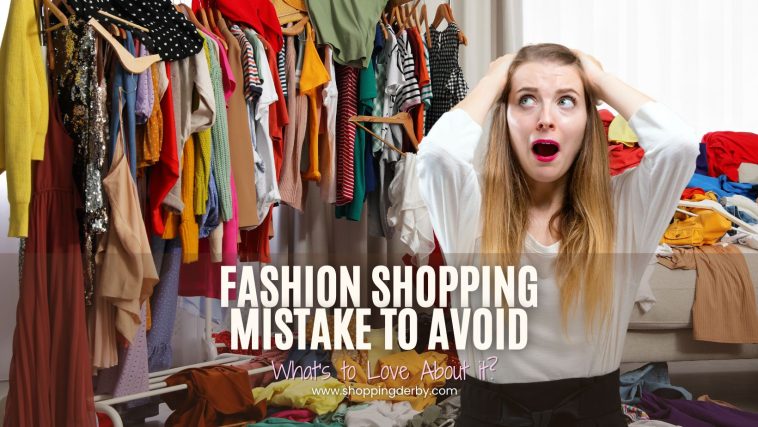Shopping for fashion can be thrilling—a chance to update your wardrobe, express yourself, and keep up with the latest trends. But how often have you come home with items you regret buying? Perhaps a dress still has its tags months later, or those trendy shoes aren’t as comfortable as they seemed in the store. The truth is, many women unknowingly fall into fashion shopping mistakes that lead to wasted money, stress, and cluttered closets.
These fashion shopping mistakes aren’t just frustrating; they can also hinder your ability to develop a wardrobe that truly reflects your style and meets your needs. But the good news? You can avoid these mistakes with just a bit of planning and awareness. Let’s dive into the most common errors women make when shopping for fashion and explore practical solutions to ensure every shopping trip is a success.
How to Avoid These 10 Common Fashion Shopping Mistakes
1. Shopping Without a Plan
The Mistake:
Walking into a store or browsing online without a clear idea of what you need. This often leads to buying clothes that you don’t actually wear or that don’t fit your style. Unplanned shopping also makes you more susceptible to impulsive decisions and purchases.
Why It Happens:
This mistake happens because shopping can feel recreational—many people go to malls or scroll through e-commerce platforms out of boredom or as a way to de-stress. The excitement of discovering something new or the influence of limited-time deals can lead to buying items without considering their utility.
Solution:
- Create a shopping list: Just like when grocery shopping, jot down exactly what you need—be it a formal dress for an event, comfortable sneakers, or a replacement for a worn-out jacket.
- Audit your wardrobe: Look through your closet before heading out to avoid buying duplicates or unnecessary items. You might find you already own something that works.
- Set a budget: Assign a realistic spending limit for your trip. This keeps your shopping focused and prevents overspending.
2. Ignoring Quality for a Low Price
The Mistake:
Purchasing inexpensive clothing items that are poorly made and don’t last. These pieces may seem like a good deal, but their wear and tear can lead to constant replacements, costing more in the long run.
Why It Happens:
Sales, discounts, and fast fashion trends encourage consumers to prioritize quantity over quality. Items marked down to seemingly irresistible prices make it tempting to overlook signs of poor craftsmanship.
Solution:
- Learn to identify quality: Look for double-stitched seams, sturdy zippers, and fabric that feels thick and durable. Avoid garments that feel flimsy or poorly assembled.
- Invest in wardrobe staples: For pieces you’ll wear frequently, such as jeans, coats, or workwear, opt for higher-quality brands. Spending more upfront means better value over time.
- Practice cost-per-wear thinking: Divide the cost of the item by how many times you’ll realistically wear it. A $100 dress worn 10 times costs $10 per wear, while a $10 dress worn once costs the same.
3. Buying Trends That Don’t Suit You
The Mistake:
Getting swept up in the latest fashion trends, even when they don’t flatter your body type, match your personality, or suit your lifestyle.
Why It Happens:
Trendy pieces often dominate store displays, fashion blogs, and social media platforms. The pressure to stay fashionable or fit in with current styles can make you feel like you need these items, even if they’re impractical for your daily life.
Solution:
- Know your style: Reflect on your preferred colors, cuts, and materials. Write down what works best for you and stick to it, regardless of trends.
- Evaluate trends critically: Just because a piece is “in” doesn’t mean it’s right for you. Ask yourself if the trend aligns with your existing wardrobe and personal taste.
- Try before you buy: Test trendy items in the dressing room to ensure they complement your body shape and fit well.
4. Skipping the Dressing Room
The Mistake:
Buying clothing without trying it on, leading to items that don’t fit correctly or feel uncomfortable once you wear them.
Why It Happens:
Sometimes, the hassle of waiting in line for a dressing room or feeling rushed during a shopping trip leads people to skip this crucial step. Online shoppers face even greater challenges since trying on before purchasing isn’t an option.
Solution:
- Dedicate time to trying items: When shopping in person, ensure you test the fit, length, and comfort of each piece before purchasing.
- Know your exact measurements: For online shopping, measure your bust, waist, hips, and inseam, and keep these handy for comparison with sizing charts.
- Read online reviews: Look for comments on sizing, fit, and material quality to gauge whether an item is likely to meet your expectations.
5. Forgetting About Versatility
The Mistake:
Buying pieces that can’t be mixed and matched with other items in your wardrobe, limiting their usability.
Why It Happens:
Attractive displays and unique designs can make a single piece irresistible, even if it’s challenging to pair with other items.
Solution:
- Think about your current wardrobe: Before buying, imagine at least three outfits you can create using the piece with items you already own. If you can’t think of any, it might not be worth purchasing.
- Focus on wardrobe staples: Invest in basic, neutral-colored clothing that complements multiple styles and occasions.
- Plan outfits: Use apps or Pinterest to visualize and plan cohesive outfits around your potential purchase.
6. Ignoring Return Policies
The Mistake:
Forgetting to check or understand the return policy and ending up with items you can’t return or exchange.
Why It Happens:
The excitement of making a purchase can overshadow practical considerations. Some women may assume they can return anything, only to realize too late that it’s not allowed.
Solution:
- Read return policies carefully: Before purchasing, especially online, review the store’s policy regarding returns, exchanges, and restocking fees.
- Save all documentation: Keep receipts, tags, and original packaging until you’re certain about your purchase.
- Prioritize flexible stores: When unsure about a purchase, shop at retailers known for generous return policies.
7. Falling for Sales Hype
The Mistake:
Buying something simply because it’s on sale, not because you need or truly want it.
Why It Happens:
Sales create a sense of urgency, making shoppers believe they’re getting a once-in-a-lifetime deal. This pressure can lead to irrational purchases.
Solution:
- Stick to your list: Focus on what you intended to buy and avoid distractions from discounts.
- Ask yourself key questions: Would you purchase the item at full price? Do you genuinely need or love it?
- Pause before purchasing: If unsure, give yourself 24 hours to think it over. If the sale ends in that time, it wasn’t meant to be.
8. Ignoring Comfort and Practicality
The Mistake:
Choosing style over comfort results in items that look great but aren’t practical for daily wear.
Why It Happens:
Trendy or visually appealing pieces can overshadow the importance of comfort, especially for special events or occasions.
Solution:
- Test the fit thoroughly: Walk, sit, and bend in the clothing to ensure it’s practical for real-life scenarios.
- Consider your lifestyle: If you’re on your feet all day, prioritize comfortable shoes. If you need office wear, ensure it allows ease of movement.
- Seek balance: Style doesn’t have to come at the expense of comfort. Look for fashionable yet functional designs.
9. Overlooking Accessories
The Mistake:
Neglecting to include accessories in your shopping plans, which can leave your outfits feeling incomplete.
Why It Happens:
Clothing often takes center stage, while accessories like belts, scarves, or jewelry are seen as afterthoughts.
Solution:
- Invest in timeless pieces: A neutral handbag, classic belt, or statement necklace can enhance a variety of outfits.
- Experiment with trends: Accessories are a low-risk way to test current styles without committing to full outfits.
- Organize your collection: Keeping accessories visible and organized can help you remember to use them.
10. Not Considering Maintenance
The Mistake:
Buying high-maintenance clothing that requires special care leads to added costs and inconvenience.
Why It Happens:
Excitement over how an item looks often overshadows practical considerations like whether it’s machine-washable or needs ironing.
Solution:
- Check the care label: Opt for low-maintenance items that fit your lifestyle.
- Be realistic: Avoid items requiring care you’re unlikely to follow through with, like hand washing or frequent dry cleaning.
- Plan for care costs: Factor in the long-term costs of maintaining the item before buying.
Conclusion
Fashion shopping mistakes are incredibly common, but they’re also entirely avoidable with a bit of foresight. By planning your purchases, prioritizing quality, and focusing on versatility, you can build a wardrobe that works for your lifestyle and reflects your personal style. The key is to shop with intention and resist the urge to buy on impulse.
Next time you go shopping, remember that every purchase should feel like an investment—not just in your wardrobe but in your confidence and comfort. Avoid these pitfalls, and you’ll not only save money but also feel great about every piece you own. Shopping smart is all about making choices that align with your needs, preferences, and goals.



